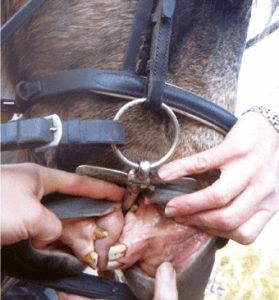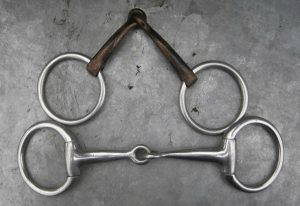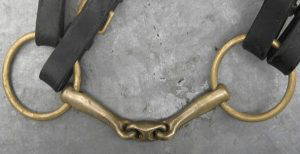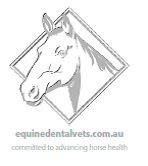 If you want a topic to spark a conversation, generate some controversy or perhaps motivate someone to produce the collection of bits they’ve bought and tried over the years then this is certainly it. Whilst I make no claims to be an expert on the subject, as a equine dental veterinarian I know horse’s mouths well, and over the years I have identified some simple, common mistakes and problems that affect many horses and riders. I’ve also discovered that sharing this information with horse riders has invariably had a positive response. As a result I’ve helped many horses and riders solve bitting issues and move-on from the frustration, the expense and the headaches allowing them to get on with what they really want to do – go riding!
If you want a topic to spark a conversation, generate some controversy or perhaps motivate someone to produce the collection of bits they’ve bought and tried over the years then this is certainly it. Whilst I make no claims to be an expert on the subject, as a equine dental veterinarian I know horse’s mouths well, and over the years I have identified some simple, common mistakes and problems that affect many horses and riders. I’ve also discovered that sharing this information with horse riders has invariably had a positive response. As a result I’ve helped many horses and riders solve bitting issues and move-on from the frustration, the expense and the headaches allowing them to get on with what they really want to do – go riding!
Many choices one signal To understand the basics of bitting you need to first understand that all the equipment used to communicate with the horse via reins and ropes works through the application of pressure signals. Pressure is the signal that motivates the horse to yield, bend or alter its course or pace.
Whether they are in the mouth or outside the mouth, bridles and halters work as training aids through the application and release of
pressure. The basic principle is you apply a pressure signal, and when the horse responds correctly, you release the pressure. That’s how horses learn to respond to the rider’s signals. What changes, depending on the type of bit or bridle used, is the location of that pressure and how much pressure is created from the same amount of pressure applied by the rider. It is important to understand this because, provided your horse is comfortable, their bit
and bridle fits well and you as a rider are safe and can communicate with your horse using deliberate signals and releasing the pressure at the right time, the type of bit or bridle you use is often less important than how you use it.
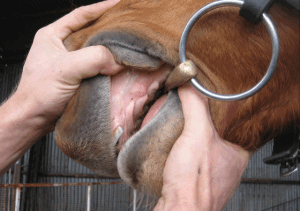
young TB horse. Photo courtesy Advanced Equine Dentistry
The right fit
Let me explain why this is so important – how often have you sought bitting advice from a neighbour or perhaps more experienced friend? Often the advice might be … “Well I ride in this bit and have no problems – perhaps you should try it in your horse”
Now let’s try that same scenario but with cars instead of horses… “Well I have these wheels on my car and have no problems perhaps you should try them.”
You can see that, whilst you might get lucky, the wheels might actually fit the car and have the appropriate tyres, it is really just guess-work and, in a high percentage of situations, the wheels will not fit the car.
The same principle applies with bitting horses – the fact that one bit works for one horse and rider combination is no guarantee that bit will work for you and your horse.
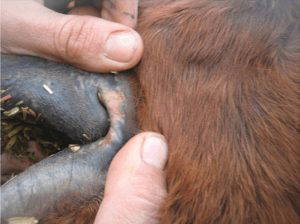
courtesy Advanced Equine Dentistry.
Let’s set an example: The bit your friend uses on an 8-year-old Thoroughbred for show jumping is not necessarily going to fit your 10-year-old Stock Horse you ride at pony club. We need to do a bit more investigation when it comes to fitting bits.
So let’s look at some of the simple, common sense points when choosing or fitting a bit to your horse.
- How old is your horse?
- What education does your horse already have?
- How much education do you as a rider have?
- What do you do or plan to do with your horse?
- How often will you actually work your horse?
- Do the disciplines you compete in mean you have to choose certain types or groups of bits?
Before we delve any further, let’s go back to the example of the car’s wheels and tyres. We talked before about seeing many bits on display in saddleries and it’s not unusual to get bitting advice from the staff at these stores. Think carefully, however, about whether it’s possible to fit tyres to a car without having the actual car to examine!
Once again, while it is possible to give general bitting advice and sell bits and bridles from a store, even the most experienced rider will struggle to accurately and repeatedly sell a bit to fit a horse without ever seeing the horse and its mouth in the first place.
That’s not to say that you can’t or shouldn’t purchase tack from a saddlery, but try to provide the saddlery with as much information as possible including some simple measurements or photos. If this still doesn’t yield a good result, then it may be worth consulting someone with experience at examining and fitting bits to horse’s mouths.
Simple physics
Let’s look at some examples of why this is important.
Let’s say we take the fairly common example of an off-the-track Thoroughbred about 6 to 7-years-old.
This same horse, wearing the same bit and bridle and ridden by the same rider, will experience a different action of the bit when they shift from a gallop to say a trot or a canter in a round frame.
This is because at the gallop the horse’s head and neck are extended and the rider’s hands will work back on the reins towards the horse’s shoulder, the action of the bit will be back across the lip corners (the commisures).
Whereas with the horse in a round frame, with their head on the vertical, the areas of pressure of the bit will be across the bars of the mouth and the tongue.
The movement of the bit will also have changed, as the different gaits and speeds affects the bit moving inside the horse’s mouth.
So you see, without changing the rider, the horse or the tack we can get two very different actions of the bit in the same horse just based on the type of work he’s doing
What’s going on inside?
The next thing to talk about is the age of the horse.
Horses are different to people in that they have what are called Hypsodont teeth. This is very relevant to bitting of horses, because a Hypsodont tooth continues to erupt (it does not grow) over the horse’s life. The effect of this is that at different ages there will be more or less space in the diastema (the space between the front teeth and the cheek teeth where the bit sits) and this will have an impact on the thickness of bit that will fit comfortably in the horse’s mouth.
This means that you are likely to have more flexibility of bit choice in your horse when he is 10 than when he is 3 and, as that same horse becomes older, the bit that fit him when he was a 10-year-old may not fit it as a 20-year-old.
At the moment we have been discussing the same horse, but if we now start to compare different horses we see that each is different not only at different ages but also from each other.
We could take three thoroughbred geldings as an example, all the same age and size and all bred by the same stallion. Whilst their head shapes might be similar, the length of their bars, the width of their bars and the height between the bars and the palate will all be different, as will the thickness of their tongues. None of these things can be seen from just looking at the outside of the horse’s head. Only by flipping the horse’s lip can we begin to check and measure these distances.
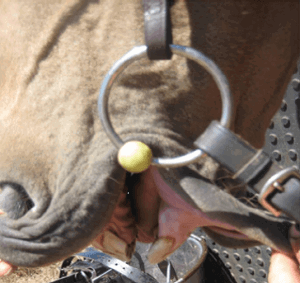
horse to close its mouth. As well as being dirty, this bit is making
painful contact with this pony’s upper canines.
Simple tips
So … What are some common sense, simple tips all horse owners can take from this article that
may help them comfortably fit a bit to their horse?
Number 1
Generally speaking when the bit is correctly fitted there should be approximately 1/2 to 1 inch either side of the lip commissures. This is not always the case but you certainly don’t want the bit any wider than this as you risk it sliding through the horse’s mouth.
Number 2
Check the thickness of the cannons (the mouthpieces either side of the joint/s) either by fitting the bit, flipping the lip and looking at the amount of pressure on the tongue and palate without rein contact, or by carefully sliding your finger through the diastema over the tongue and using it as a guide to how much space exists between the tongue and the roof of the mouth.
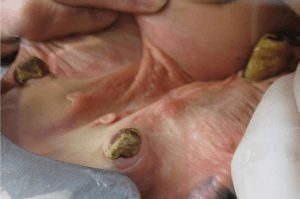
your bridle and bit fit during his regular check up.
Number 3
Flip the lip and ensure the bit is not sitting too low, i.e, contacting canine teeth in males, or too high (your horse has a permanent smile).
Number 4
For most bridle designs, start at the top of the cheek pieces and ensure the bit is adjusted to have an equal number of holes from the top on both sides.
Number 5
Examine the corners of the lips (the commissures) before and after every ride (e.g. when you put on the bridle and when you take off the bridle) for signs of cutting, bruising or chafing.
Moving on from these simple tips what else should you do to ensure your horse is comfortable?
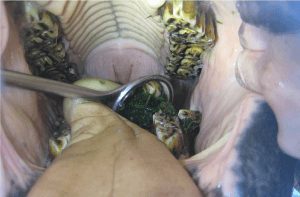
dislodged – Another reason why regular dental vet care is crucial.
First and foremost be attentive… How many times have I asked an owner during a consult if the horse is having any issues and the answer is either “No, not at all” or “Oh sure, but that’s because of an issue with the horse’s back, etc.”
Don’t be afraid to talk to your vet about your horse, information is what we, as vets work with. So if you don’t talk to us about your horse it can be difficult to identify the cause of a problem. Remember, as owners and riders you spend far more time with your horse than we do, so things you notice might be important. Talk to your vet, and don’t discount anything without looking into it first.
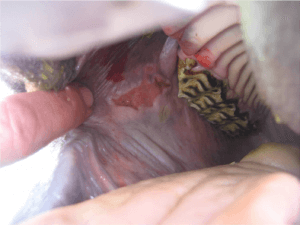
sharp points have caused deep lacerations to his cheek lining.
Signs that your horse may have a bitting problem
Does your horse lug? Do they chew the bit? Do they have more resistance one way? Do they tip their head? Do they try to get above or below the contact?
This is not an extensive list but gives you an idea of some things to think about.
As we discussed at the beginning of the article, bits, bridles, hackamores, bosals and halters all work through providing signal (or pressure) to the horse so if your horse is not comfortable in the mouth then they will experience pain – no matter how well fitted the bit and bridle are. So it’s an important part of bitting that all horse receive regular, competent dental exams and treatment from an equine dental vet
This includes young horses prior to any form of mouthing and horses that may have undergone a significant spell.
When getting to terms with a problem remember that all horses’ teeth contain nerves so if you have contact between a tooth and the bit there is often pain, especially in smaller crowned teeth such as canines and wolf teeth.
Bit design
We talked earlier about the wide array of shiny bits on display in the saddlery. Whilst it is far too large a topic to cover in detail here, let’s look at some of the simple principles of bit design.
Firstly to the rudimentary parts of most bits
The mouthpiece is a general term to describe the section of the bit that sits inside the horse’s mouth. There are many different styles and designs, however breaking it down into simple categories we have solid mouthpieces (no articulation or joins
Then come jointed mouthpieces, which can be further divided into single and double jointed.
We have not yet discussed ring design, bit thickness, bit material, leverage, bits used with a double bridle etc, yet already we have three bit broad bit designs that each differ significantly in their design and how (where) they apply pressure (signal) to the horse.
Many variations and additions to these three basic designs exist – the use of rollers, spoons, ports and other modifications have been tried during the evolution of bit design.
Fundamentally, a solid mouthpiece (sometimes with a gentle curve across it’s surface) can supply a more evenly distributed pressure across the horse’s tongue and bars, however, it can also provide (as can all bits) significant stopping power (read pressure). Mouthpieces like this are often used for in ponies because of the size of a pony’s mouth (some horses and ponies strongly
resent palatal pressure) and because ponies are usually ridden by very young riders who are unable to apply strong pressures.
Moving to bits with a joint – most of you will be familiar with a single jointed vs a double jointed mouthpiece. A single jointed mouthpiece has only one central point around which it can pivot, as a result as rein pressure is increased more pressure is applied to the roof of the mouth (palate) and over the edges of the tongue and bars – the so called “nut cracker” effect. This is not in itself a problem nor poor design, many many horses have been educated in and compete in simple single jointed bits, again it comes back to understanding how a bit works, where it applies pressure, how it is correctly fitted and how it should be used. Bit makers have also designed alternatives to the traditional joint in a single jointed mouthpiece to limit or prevent the nutcracker effect and reduce palatal pressure.
Moving to double jointed mouth piece designs, such as the “French snaffle” the two cannons (each half of the mouth piece) are connected by a third ‘lozenge’ like centre. This creates two pivot points so the pressure from this mouthpiece is across the tongue, the bars and the lips as the mouthpiece rounds across the tongue. One point on this, many of these designs as loose ring, so the cannons slide loose on the rings to which the reins attach. This means that in the horse’s mouth, the cannons of the bit will naturally “fall” to the most dependant point unless the horse is grabbing the bit. This concept is important is because this affects the position of the cannons in the horse’s diastema. Try it for yourself – pick up a thick cannoned, double-jointed, loose ring bit and try to get it to sit in any position other than the most dependant point.
Direct action or leverage?
Now because we are running out of time let’s look at the next main type of bit design. The direct action bits (like the ones we have just been discussing) vs leverage bits. The key difference between the two is that, with the direct action bits the amount of pressure on the horse’s mouth is equal to the amount of pressure applied to the reins by the rider. Whereas leverage bits, such as gag bits, Pelhams, curbs etc. work by increasing the pressure on the horse’s mouth, this is because there is a lever (shank) between the rider’s hands and the mouthpiece which acts to multiply the pressure. The amount of increase is determined by the length of the lever or shank.
There is no inherent problem with this type of bit design and again many people successfully compete in them across many disciplines. The key is understanding that the real aim of this type of bit design is to apply the same amount of pressure in the horse’s mouth as with other designs, i.e., to reduce the amount of pressure applied by the rider. These bits will also be used because they apply pressure to the horse’s poll and therefore encourage the horse to lower their head. It is when these bits are used incorrectly or as an attempt at compensation for ‘poor hands’ or incorrect training that we run in to trouble
Here is another great qoute from Benjamin Latchford on the subject of bitting that’s as true today as it was in 1871
“On no account punish the horse; on no account hurt his mouth. When my friends have come to me concerning their un-manageable horses, I invariably find the poor animal has been over bitted, or wrongly bitted, and recommend the easiest kind of bit, which, in nine cases out of ten, succeed. But there are exceptions to this rule; occasionally I have met with a good bred horse, the skin of whose mouth is very thick, thereby requiring a sharper mouthpiece to accommodate the sense of feeling; but certainly never over-bit the horse.”
We’ve skipped over many aspects of bit and bridle design, we haven’t talked about ring design, bit material, bit weight, bridles, hackamores etc
But as you can hopefully see, although it’s a bigger topic than we could ever hope to cover in just one article, by adopting some common sense principles to bits and bitting and by remembering to ‘flip the lip’ before and after every ride, hopefully, bitting will be less of a mystery to you.
Search
Recent Articles
- How to take a horse from SHOES to BAREFOOT with Alex Ridgeway & Dr Mark Caldwell
- 8 Laminitis Myths Busted!
- I’ve learnt as I’ve got older to really listen to what the people around me say about others
- The dangers of sleep deprivation in horses
- The third part of our series on stretching and flexibility with Sharon Stuart or Stuart Equine – forelimb and neck stretches for the horse and shoulder stretches for the rider
Categories
- Advice Hub
- Athlete
- Carriage Driving
- Dentistry
- Dressage
- Endurance
- Eventing
- Farrier
- Featured
- Featured Horse Ads
- Featured Posts
- Horse Racing
- Horse's Mouth
- Horseball
- Hunting
- Le Trec
- Leisure Riders
- Mounted Games
- Nutrition
- Polo
- Polocrosse
- Reining
- Rescue & Rehabilitation
- Show Jumping
- Showing
- Tack Room
- Team Chasing
- The Pony Club
- Therapy
- Training
- Vaulting
- Veterinary



